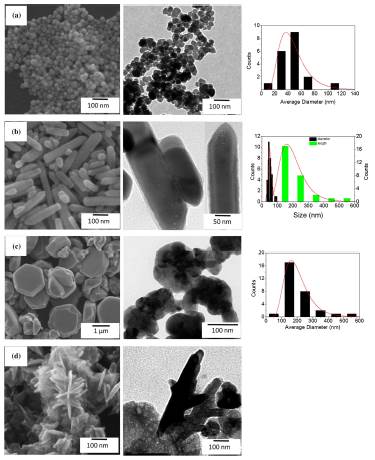ZnO nanoparticles, nanorods, hexagonal plates and nanosheets produced by polyol route and the effect of surface passivation by acetate molecules on optical properties.
BARBOSA, Eduardo F.; COELHO, Jaqueline A.; SPADA, Edna Regina; AMORIM, Daniel Roger Bezerra; SOUSA, Livia Maria de Castro; CORDEIRO, Neusmar J. A.; SANTANA, Henrique de; DUARTE, José L.; FLORIANO, João B.; SCHREINER, Wido H.; MACEDO, Andreia G.; FARIA, Roberto Mendonça; RODRIGUES, Paula C.
BARBOSA, Eduardo F.; COELHO, Jaqueline A.; SPADA, Edna Regina; AMORIM, Daniel Roger Bezerra; SOUSA, Livia Maria de Castro; CORDEIRO, Neusmar J. A.; SANTANA, Henrique de; DUARTE, José L.; FLORIANO, João B.; SCHREINER, Wido H.; MACEDO, Andreia G.; FARIA, Roberto Mendonça; RODRIGUES, Paula C.
 Abstract: We carried out synthesis of shape-controlled ZnO nanoparticles following a polyol route using either ethylene glycol (EG) or polyethylene glycol (PEG) as solvent, which exhibited wurtzite structures as identified by XRD patterns. Transmission electron microscopy (TEM) and scanning electron microscopy (SEM) analyses of the synthesized structures showed that the size and the shape are strongly dependent on the reaction medium, resulting in nanospheres, rods, hexagonal plates or sheets, which were characterized by different spectroscopy techniques such as: Raman scattering, x-ray photoelectron spectroscopy (XPS), UV-Vis and photoluminescence (PL). The Raman analysis showed that the resulting surface is passivated with acetate molecules and also monitored the presence of superficial defects, whose spectroscopic patterns (Raman spectroscopy) indicated that the passivation with acetate molecules reduces the number of defects, such as oxygen vacancies. This result was confirmed by XPS analyses that identified chemisorbed oxygen species onto the oxide surface and an oxygen-deficient component in the sample prepared as reference, without a passivation with EG or PEG. Photoluminescence results showed that the passivation, size and shape of the particles influenced the optical features, mainly at the emission at the green region of spectrum that has been related with surface defects. This green emission is favoured at the ZnO sample prepared without passivation and with large amount of defects. Current-voltage characteristic (J-V) of an inverted organic solar cell showed the potential application of these ZnO nanostructures as electron transport material in organic photovoltaic devices. Abstract: We carried out synthesis of shape-controlled ZnO nanoparticles following a polyol route using either ethylene glycol (EG) or polyethylene glycol (PEG) as solvent, which exhibited wurtzite structures as identified by XRD patterns. Transmission electron microscopy (TEM) and scanning electron microscopy (SEM) analyses of the synthesized structures showed that the size and the shape are strongly dependent on the reaction medium, resulting in nanospheres, rods, hexagonal plates or sheets, which were characterized by different spectroscopy techniques such as: Raman scattering, x-ray photoelectron spectroscopy (XPS), UV-Vis and photoluminescence (PL). The Raman analysis showed that the resulting surface is passivated with acetate molecules and also monitored the presence of superficial defects, whose spectroscopic patterns (Raman spectroscopy) indicated that the passivation with acetate molecules reduces the number of defects, such as oxygen vacancies. This result was confirmed by XPS analyses that identified chemisorbed oxygen species onto the oxide surface and an oxygen-deficient component in the sample prepared as reference, without a passivation with EG or PEG. Photoluminescence results showed that the passivation, size and shape of the particles influenced the optical features, mainly at the emission at the green region of spectrum that has been related with surface defects. This green emission is favoured at the ZnO sample prepared without passivation and with large amount of defects. Current-voltage characteristic (J-V) of an inverted organic solar cell showed the potential application of these ZnO nanostructures as electron transport material in organic photovoltaic devices. | |
| Journal of Electronic Materials |
| v. 48, n. 10, p. 6437-6445 - Ano: 2019 |
| Fator de Impacto: 1,676 |
| http://dx.doi.org/10.1007/s11664-019-07446-6 |  @article={002965970,author = {BARBOSA, Eduardo F.; COELHO, Jaqueline A.; SPADA, Edna Regina; AMORIM, Daniel Roger Bezerra; SOUSA, Livia Maria de Castro; CORDEIRO, Neusmar J. A.; SANTANA, Henrique de; DUARTE, José L.; FLORIANO, João B.; SCHREINER, Wido H.; MACEDO, Andreia G.; FARIA, Roberto Mendonça; RODRIGUES, Paula C.},title={ZnO nanoparticles, nanorods, hexagonal plates and nanosheets produced by polyol route and the effect of surface passivation by acetate molecules on optical properties},journal={Journal of Electronic Materials},note={v. 48, n. 10, p. 6437-6445},year={2019}} @article={002965970,author = {BARBOSA, Eduardo F.; COELHO, Jaqueline A.; SPADA, Edna Regina; AMORIM, Daniel Roger Bezerra; SOUSA, Livia Maria de Castro; CORDEIRO, Neusmar J. A.; SANTANA, Henrique de; DUARTE, José L.; FLORIANO, João B.; SCHREINER, Wido H.; MACEDO, Andreia G.; FARIA, Roberto Mendonça; RODRIGUES, Paula C.},title={ZnO nanoparticles, nanorods, hexagonal plates and nanosheets produced by polyol route and the effect of surface passivation by acetate molecules on optical properties},journal={Journal of Electronic Materials},note={v. 48, n. 10, p. 6437-6445},year={2019}} |



